I’ve worked in the digital marketing space for more than a decade and this online marketing glossary contains every marketing definition you could ever need. There are many online marketing glossaries out there but this one is unique because it wasn’t written by a virtual assistant 😋

- 301 Redirect
- 404 Error
- AB Testing
- AIDA
- AM – Affiliate Manager
- API – Application Programming Interface
- Above The Fold
- Ad Copy
- Ad Extensions
- Ad Network
- AdSense
- Adlergic / Ad Fatigue
- Ads.txt
- Advertising Budget
- Advertorial
- Adware
- Affiliate Marketing
- Affiliate Network
- Alt Text
- Analytics
- Anchor Text
- Autoresponder Series
- B2B – Business To Business
- B2C – Business To Consumer
- Banner Ad
- Behavioural Targeting
- Below the fold
- Big Data
- Black Hat / Grey Hat / White Hat
- Blogging
- Bounce Rate
- Brand Positioning
- Breadcrumbs
- CMS – Content Management System
- CPA Cost Per Acquisition
- CPL – Cost Per Lead
- CPM – Cost Per Mille
- CR – Conversion Rate
- CRM – Customer Relationship Management
- CRO – Conversion Rate Optimisation
- CSS – Cascading Style Sheets
- CTA – Call To Action
- CTR – Click Through Rate
- CPC – Cost Per Click
- Canonical
- Churn
- Cold Call / Cold Mail
- Competitive Advantage
- Content Marketing
- Cookie
- Copywriting
- Core Value Proposition
- Core Web Vitals
- Crawling / Scraping
- Creatives
- DNS – Domain Name System
- Deep Linking
- Demographic Targeting
- Direct Response
- Email List
- Featured Snippet
- GSC – Google Search Console
- Google Tag Manager
- Guerrilla Marketing
- H1,H2,H3 Tags
- HTML – Hyper Text Markup Language
- Hashtag
- Heatmaps
- IP Address
- Iframe
- Influencer Marketing
- Infographic
- JS – JavaScript
- Jump Page
- KPI – Key Performance Indicators
- Keyword Density
- LTV – Lifetime Value
- Landing Page
- Lead Magnet
- Lead Nurturing
- Lookalike Audience
- Loss Aversion
- MRR – Monthly Recurring Revenue
- Marketing Automation
- Market Research
- Meta Tags (Meta Description & Meta Keywords)
- MVP – Minimum Viable Product
- Mobile First
- MV Testing
- NLP – Neuro Linguistic Programming
- News Hacking
- Niche
- Organic Traffic
- PPC – Pay-Per-Click
- PBN – Private Blog Network
- PR – Public Relations
- Page Speed
- Performance Marketing
- Pixel
- Pop Up / Pop Under
- Programmatic Advertising
- ROAS – Return on Ad Spend
- RSS Feed – Really Simple Syndication
- Rebill
- Referral
- Responsive
- Retargeting / Remarketing
- Robots.txt
- S2S Pixel (Server To Server)
- SEO – Search Engine Optimisation (SEM – Search Engine Marketing)
- SERP – Search Engine Results Page
- SSL HTTPS
- SWOT Analysis
- Sales Funnel
- Search Engine Spider
- Search Query
- Sitemap
- Spam
- Tracking
- Tripwire
- URL – Uniform Resource Locator
- USP – Unique Selling Point
- UTM Tracking
- UX – User Experience
- Uniques
- Viral Marketing
- Wireframe
- WordPress
- XML – Extensible Markup Language
Interestingly 40% of marketing jargon starts with the letters A-C, I have no idea what this means.
301 Redirect
A 301 redirect is a server response which redirects a web browser to another page. 301 redirects can be used to create smart links to affiliate offers. So you can have a generic /out.php file which links out to 3rd party sites. If the 3rd party changes or cancels their affiliate program the affiliate can simply change the link in a single file rather than digging up every post or ad that contained the out link.
The coding language PHP is often used to send a 301 header with code like below.
<?php
header("HTTP/1.1 301 Moved Permanently");
header("Location: https://jamesbachini.com/");
exit();
?>404 Error
A 404 error is a server response that most people will have seen when browsing the web. It basically means that the web server can’t find the page that you have requested.
It might be caused by the site moving content or a mistyped link.
AB Testing
AB Testing is the process of setting up to variations of an ad, landing page or component within a sales funnel, then sending equal amounts of traffic to each. Conversions are measured to determine the most effective variation.
The worse performing ad will be removed from the test and the best performing ad will be left to run. Often a variation of the best ad will then be created to continuously improve the conversion rate of a campaign.
A/B/n testing is a variation with more than two tests of a specific component at once.
MV testing takes this a step further and tests multiple factors at the same time. An example might be having different variations of images, headlines, colours on a landing page all being tested individually to find the best combination.
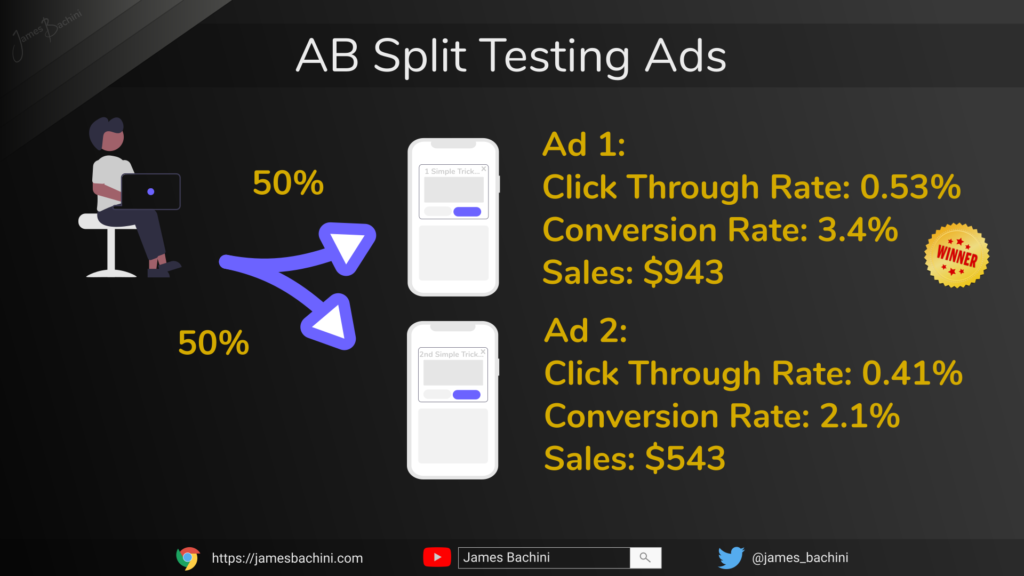
AIDA
AIDA is an acronym for Attention Interest Desire Action.
It’s a framework used often in copywriting to map out sales content.
There’s a full section on copywriting frameworks including AIDA in the module on copywriting here:
https://jamesbachini.com/copywriting-for-websites/#Copywriting-Frameworks
AM – Affiliate Manager
As an affiliate your main point of contact with an affiliate network that provides the offers will be through an AM or affiliate manager. These reps are responsible for setting rates, providing information on new offers and pausing campaigns when necessary.
Be nice to your AM’s.
API – Application Programming Interface
An API is a back end service that web based data providers and services use to connect programmatically. An API provides an easy access point for developers to connect and leverage 3rd party data and services.
Above The Fold
Above the fold is a classification for a banner ad that is placed in the viewable part of the screen when a page first loads. Below the fold in contrast is an ad placed outside the viewable window further down the page that the visitor will only see if they scroll down the page.
Above the fold ads command higher price points because they have more visibility and higher click through rates.
Ad Copy
Ad copy is the text or copywriting that is used within an ad or landing page.
It is often persuasional text designed to influence an outcome and generate a response from the reader.
Ad copy is often A/B Tested to see which text converts better.
Ad Extensions
Ad extension show additional meta data about the offer. It can be site links to additional content or a phone number for example.
Here are some examples of ad extensions in Google search ads
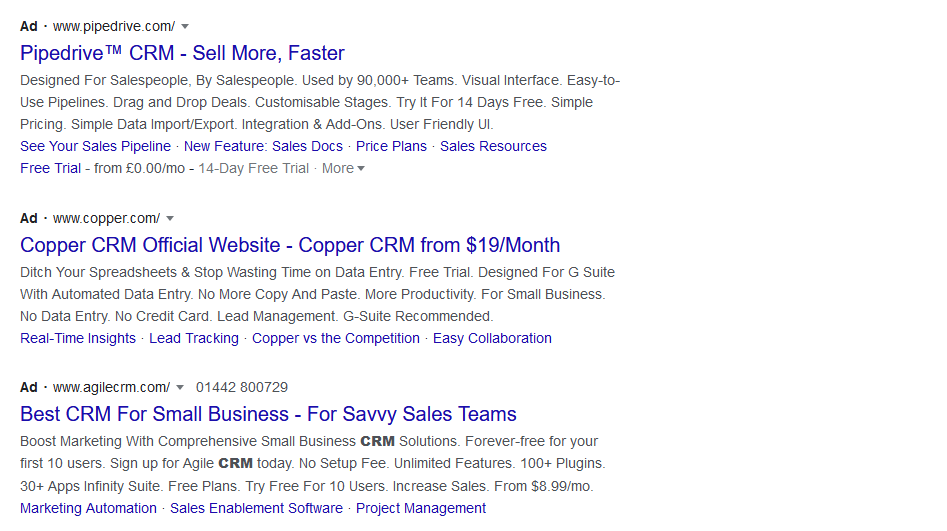
Ad Network
An ad network or advertising network is a marketplace for digital advertising. Some of the biggest companies in the world such as Facebook and Google make the majority of the revenue through the sale of digital marketing placements.
Ad networks are either fully managed or self-service. My preference is for a self-service platform which gives the advertiser full control over their campaigns.
Ad networks often contain multiple types of inventory. For example a single ad network might provide pop unders and push notification ads and these will convert completely differently. Always setup individual campaigns for each type of placement.
AdSense
The Google Adsense program is a monetisation tool where webmasters can put a code snippet on their site to display ads resold by Google.
Website owners are rewarded through monthly payments for displaying banners on their site.
Adlergic / Ad Fatigue
All ads have a lifespan curve where at the start they are very effective and then banner blindness sets in and the click through rate drops.
It’s been estimated that internet users see an average of 5000 ads per day which explains the ad fatigue.
Ads.txt
ads.txt is a simple text file which provides context about the advertising that a site contains. It is used a lot in programmatic advertising environments to improve transparency.
The publisher will place an ads.txt file in the root directory of their site. It is a standard text file that will look something like this:
google.com, pub-123456789, DIRECT, f04c47aec0932fb1Advertising Budget
An advertising budget is an allocation of capital for the purpose of marketing. This is often set out annually and divided in to monthly segments or for one off events like product launches.
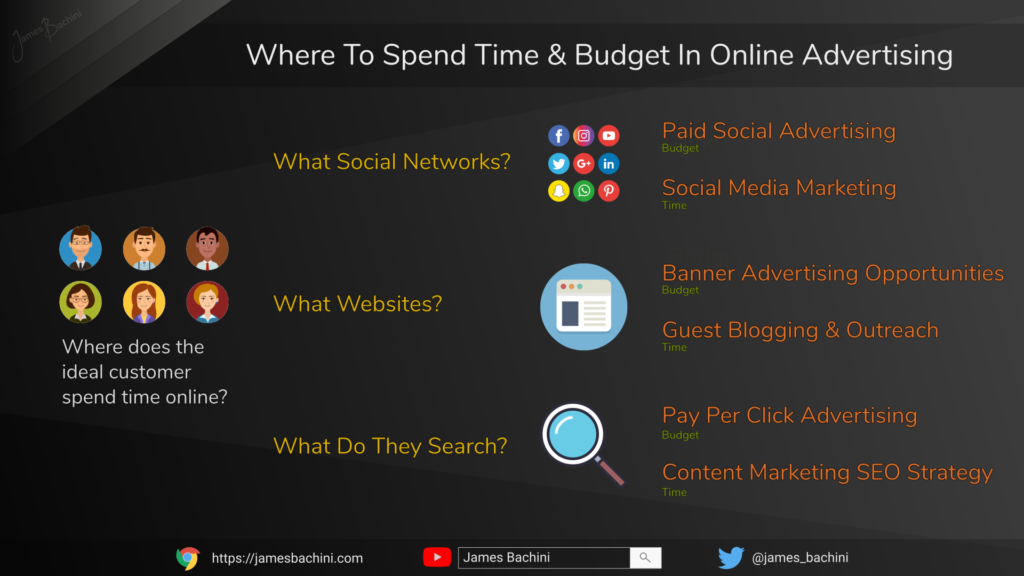
Advertorial
An advertorial is a play on words for an sponsored editorial. Sales content is written to blend in with the content and language of a site to provide an effective advertisement.
Adware
Adware is software downloaded on to your device that displays ads. This may be within the application or injected in to web pages. This became very popular with the downloadable toolbars which would then change your search provider in the early 2010’s.
Affiliate Marketing
Affiliate marketing is the process of sending traffic to an offer to earn a commission. Affiliates provide the traffic and advertisers provide the commissions and generally own the offer.
So if an advertiser owns an online shop, they might approach an affiliate network to generate some business. The affiliate network acts as a middle man and technology provider which then distributes the affiliate links out to their network of affiliates.
The affiliates go about promoting the site through all means available. When a visitor buys something in the online store it will be noted that they were sent via a specific affiliate who will earn a commission on the sale.
Affiliate Network
An affiliate network provides a marketplace and distribution network for affiliate offers.
Advertisers setup their offers with the network. Then publishers or affiliates pull affiliate links from the platform to promote. Tracking usually takes place via redirects from the affiliate networks platform.
Commissions are usually paid out to affiliates monthly although this is often negotiable if required volumes are met.
Some affiliate networks worth checking out are:
- https://www.clickdealer.com/
- https://www.maxbounty.com
- https://www.awin.com
- https://www.cj.com
- https://globalwidemedia.com
An affiliate network will often be able to provide a list of their top performing offers as a starting point for new affiliates.
Alt Text
Alt text is used to describe an image. It’s part of the HTML image tag and looks something like:
<img src=”mypic.jpg” alt=”My lovely picture” />
If the image can’t load then the alt text will render in it’s place. It is also used for screen readers.
Analytics
Analytics programs provide visitor insights for website and app owners. The most popular provider is Google Analytics who have an excellent free to use (up to 1m visitors/month) platform.
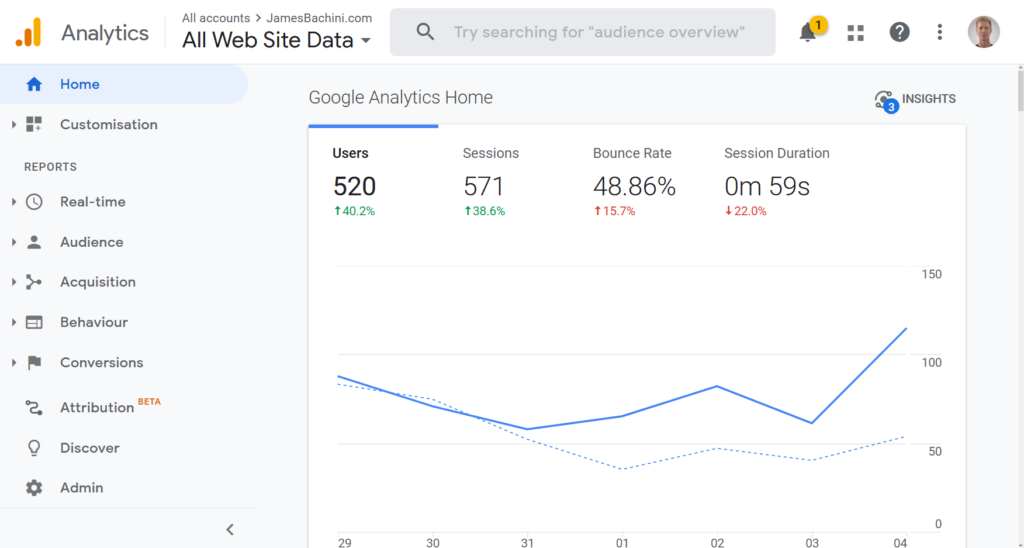
There are different stages of analytics and tracking which are best described using the analytics maturity model.
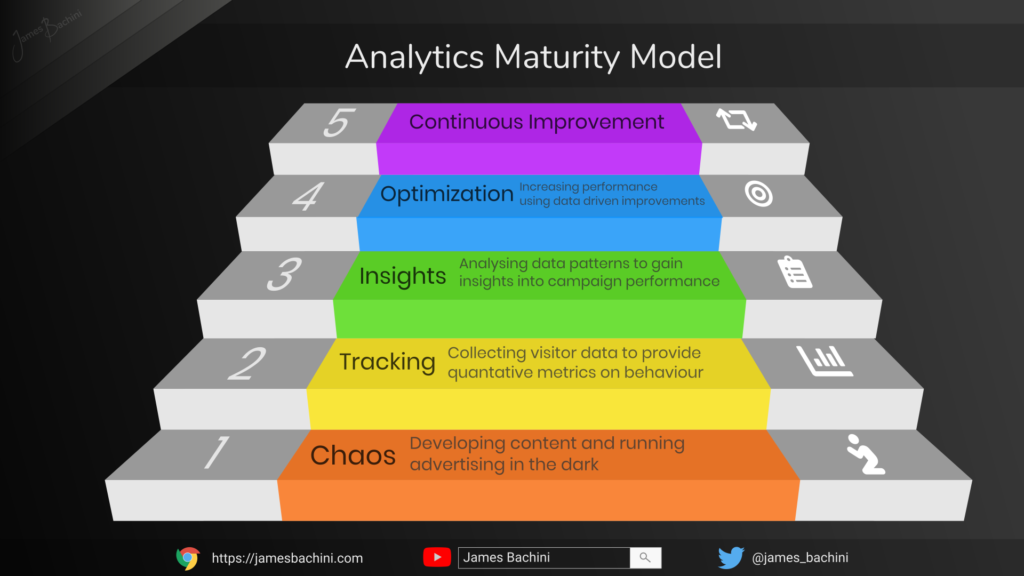
Anchor Text
Anchor text is the text used to describe and render a link
For example a link might go to https://jamesbachini.com but the anchor text might be James Bachini
This example would look and work like this:
The code for this example is below:
<a href=”https://jamesbachini.com”>James Bachini</a>
Autoresponder Series
An autoresponder series is a set of automated emails that go out at set periods after someone subscribes to an offer.
Often a lead magnet product like a PDF Guide will be given away in exchange for an email address.
Once the visitor completes the form they receive a series of emails, often over the course of a few weeks or months.
This is a lead nurturing opportunity for the marketer to communicate their brand values and product’s worth.
B2B – Business To Business
This is a business model in which a company will sell products and services to another company. An example might be an accounting firm that provides professional services for other businesses.
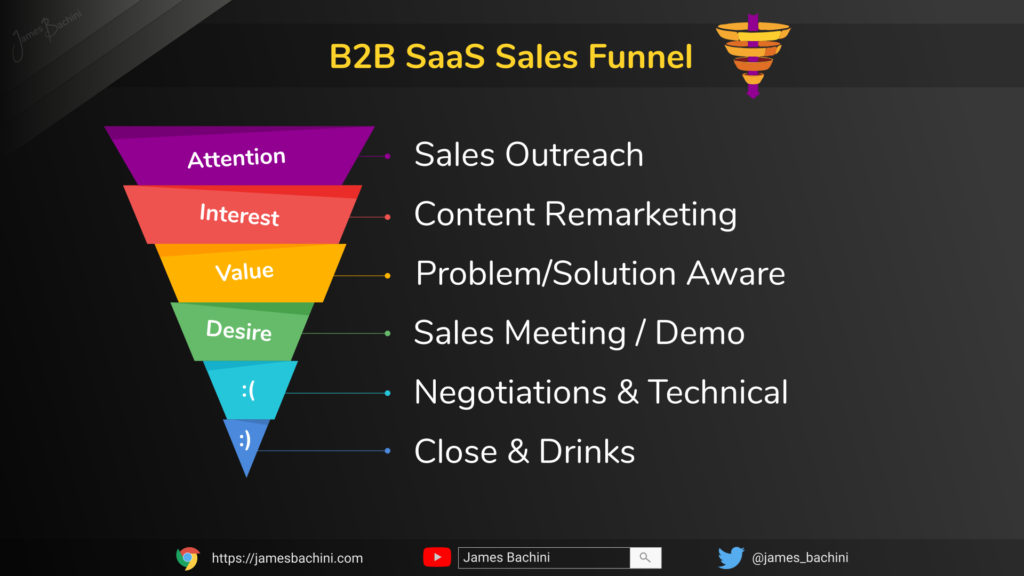
B2C – Business To Consumer
Business to consumer models in contrast sell directly to consumers of the product. An example here might be a lemonade stand where the the product is being purchased by the person consuming it.
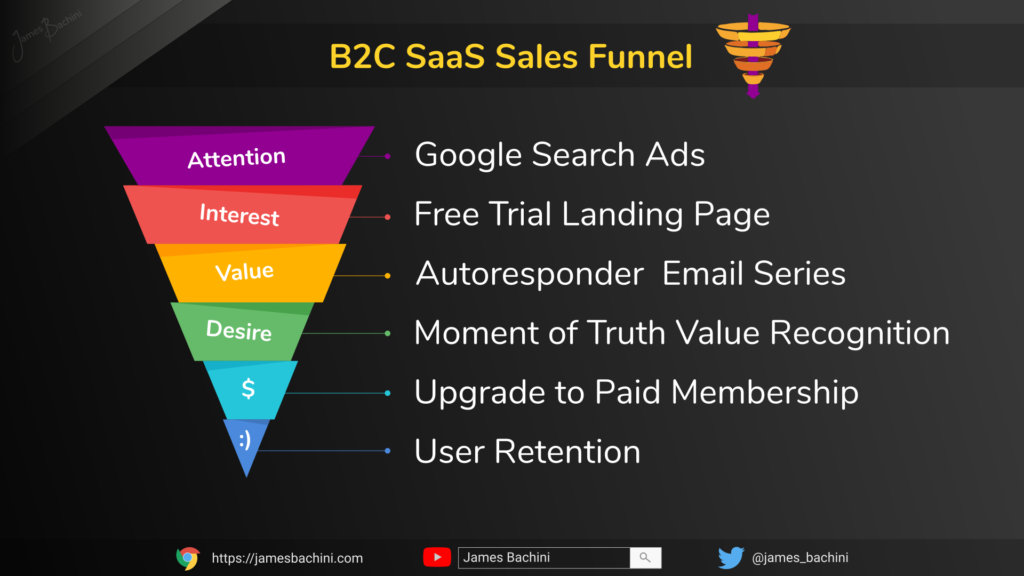
Banner Ad
A banner advertisement is an image or video ad that is displayed on a 3rd party website promoting a product or service.
Banner ads come in various shapes and sizes but the most common are:
- Standard: 300×250
- Leaderboard: 728×90
- Skyscraper: 160×600
- Mobile Leaderboard: 300×100
All sizes in px or pixels
The standard medium rectangle 300×250’s probably account for somewhere between 1/3 and 1/2 of all banner inventory across the web and display well on both mobile and desktop devices. When testing new campaigns that’s a good place to start.
Behavioural Targeting
Behavioural targeting is a service offered by ad exchanges to segment an audience by intent or previous behaviour. Companies like Google and Facebook collect data such as search queries, pages visited etc. and use that information to display relevant ads.
Behavioural targeting increases relevancy and ultimately ROAS for the advertiser.
Below the fold
Below the fold ads are displayed outside of the initial viewable content on a page or app. Users will have to scroll down the page to see the ads. This is in contrast to above the fold ads which command higher prices.
Big Data
Big data is a buzz word in marketing and more generally in business systems. Essentially it is possible and profitable to collect more data than ever on products, customers, website analytics etc.
This data can be analysed to provide business insights and make better decisions.
Black Hat / Grey Hat / White Hat
This term was originally used to describe hackers but later got adopted by the SEO community.
In essence black hat SEO goes against Google’s guidelines. Things like buying links and setting up private blog networks would be considered black hat tactics.
White hat methods are inline with guidelines so this might be guest blogging or building an audience through a podcast for example.
Grey hat is the middle ground somewhere in between.
Blogging
Blogging is a form of content creation where a person, company or brand will write articles which are posted to their site or a 3rd party service like Medium.
This website is an example of a blog and this glossary is actually a extended blog post.
The vast majority of blogs run on self-hosted WordPress. This is a CMS or content management system which means content creators don’t need to know code to create web pages.
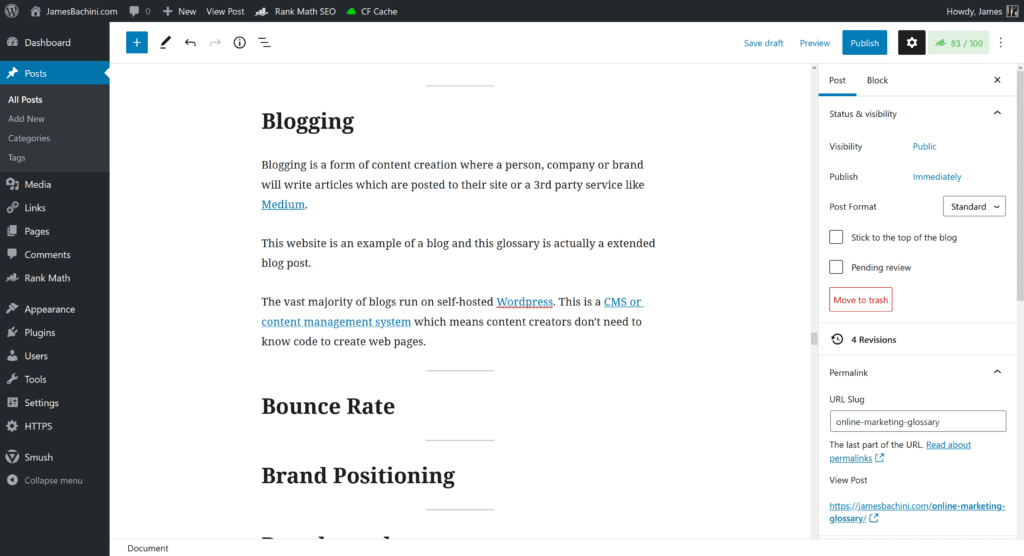
Bounce Rate
Bounce rate is the percentage of users that visit your site and then leave without visiting any other page. It can be used as a performance metric to identify the effectiveness of landing pages.
Bounce rate is widely displayed within Google analytics. There is no standard bounce rate across all sectors. Some sites that provide quick information might have a 90% bounce rate which is fine. Articles on my site get around a 50% bounce rate which is pretty standard for a blog.
Bounce rate is also a metric used in Googles search algorithm to rank sites. If a user clicks through to one search result listing for site A then returns and goes on to site B to find what they were looking for then Google +1’s Site B and -1’s Site A.
Brand Positioning
Brand positioning refers to the creation of brand image within a competitive market sector. What differentiates your business and how is this communicated to potential customers.
Effective brand positioning can ease the path to sale as well as increase long-term customer loyalty.
Breadcrumbs
Breadcrumbs are a website navigation tool which uses standard links to break down the site structure. So an internal page might have a breadcrumb like:
Home > Featured Articles > Marketing > Glossary & Terms
The user can easily see where they are at in the site and navigate back to parent pages.
CMS – Content Management System
A content management system provides a way to update a website without needing to write code. WordPress is the most popular CMS and it is estimated to power 1/3 of the sites on the web.
A CMS provides an interface a bit like Microsoft Word or Google Docs where you can type up an article, add images at the click of a button and it’s intuitive enough for anyone to be able to create content online.
Content management systems are either hosted or self-hosted. This means that either your content is displayed on a 3rd party site like Medium or you have a self-hosted version of WordPress using your own hosting or web server.
CPA – Cost Per Acquisition
Also known as cost per action it is the financial cost to gain a customer or action. So if 100 visitors go to your site at a cost of $1 cost per click then your total cost for the marketing campaign is $100. If two of those visitors make a purchase then your CPA is $50.
There are also CPA Affiliate Networks which provide commissions based on events such as sign up, form completion, app downloads etc.
CPL – Cost Per Lead
Cost per lead is the financial cost to gain one new sales lead.
If a marketing campaigns spends $500 on banner ads and gets 1000 clicks through to a landing page. Maybe the landing page has an online form leading to a lead magnet which converts at 20%. 200 people sign up for the lead magnet giving you a cost per lead of $2.50
CPM – Cost Per Mille
CPM is one of the most confusing ones because mille is 1000 not a million. So it is usually the cost per 1000 impressions of an ad.
If an ad network rep offers 100,000 impressions at $3 CPM then the traffic will cost $300.
CR – Conversion Rate
Conversion rate is a performance metric used to describe the effectiveness of a marketing system.
A landing page for example could have a conversion rate from all the visitors that go to the page to the number of users that sign up for an offer. In this case we can work out the conversion rate using this formula.
No. of Sign-ups / No of Visitors * 100
A 20% conversion rate means 1 in 5 visitors goes on to sign up for the offer.
CRM – Customer Relationship Management
If you’ve worked in any kind of large enterprise with a sales team then you have probably heard of Salesforce. This is the market leading CRM which provides a SaaS to assist sales team in lead nurturing and communications.
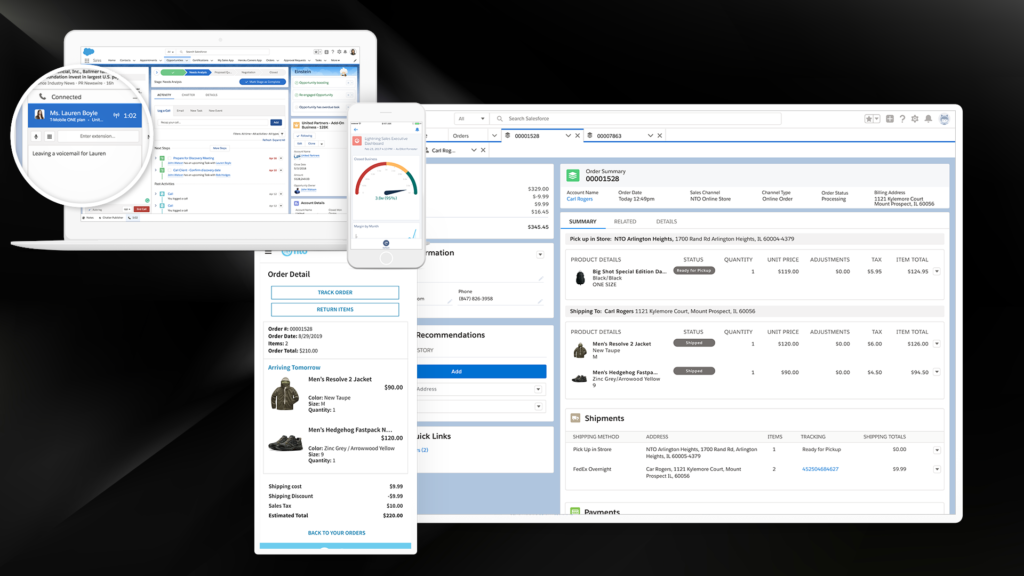
CRO – Conversion Rate Optimisation
Conversion rate optimisation is the process of improving the conversion rate of a landing page, e-commerce store or sales funnel.
This often involves A/B Testing or MV Testing different components within a funnel to find continuously improve the performance of a marketing campaign.
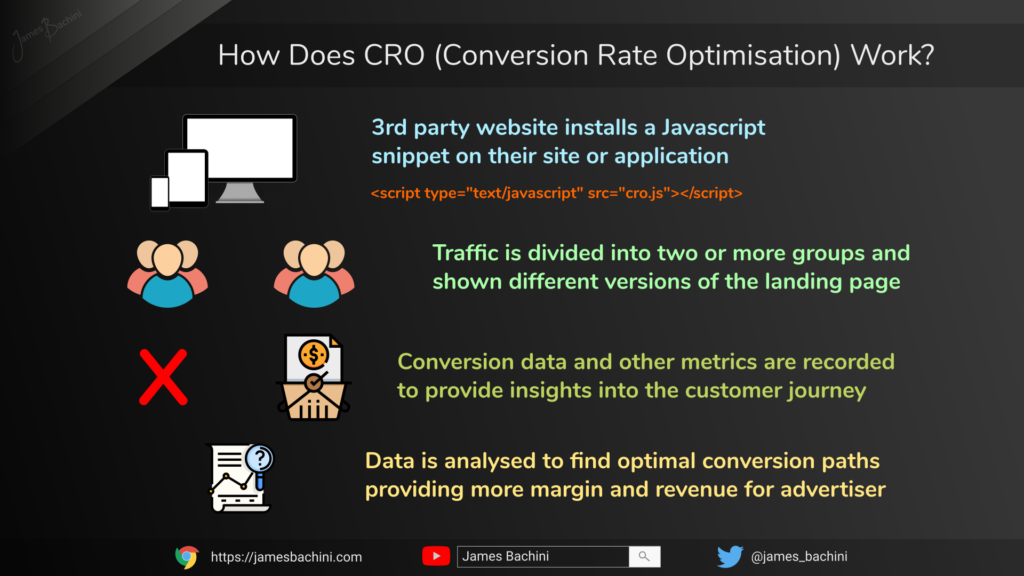
The CRO process usually follows these steps over the course of a few days to a few weeks.
- A hypothesis will be created based on previous experience for an addition or alteration to a sites base line performance.
- This will be signed off and integrated as a split test in to the website or apps code. A percentage of users will see the variation while a percentage of users will see the normal site.
- Conversion events and performance metrics will be tracked over a period of time until meaningful results are available.
- The data will be analysed to draw a conclusion and the better variation will become the baseline and rolled out across the site.
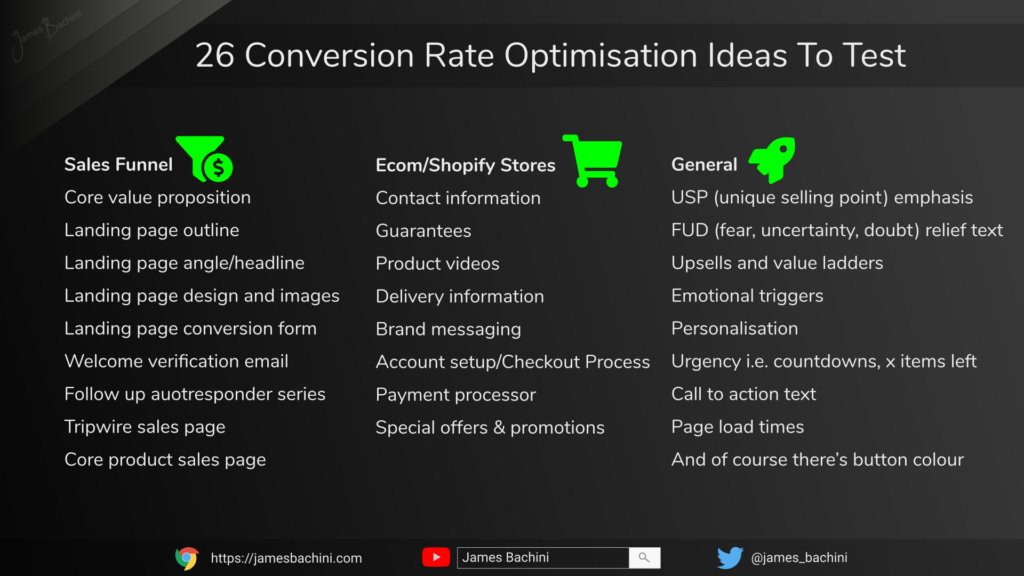
CSS – Cascading Style Sheets
CSS is a styling language used throughout the web. Almost every web page online will have CSS code which sets the layout of the site. Things like font size, text colour, paragraph spacing, image placements and dynamic menus are all set out using CSS.
CSS is also really useful to learn if you want to level up your WordPress editing skills. You can add CSS as a custom HTML block to modify the appearance on a page.
Hello CSS
The code to render this is:
<p class="css-example">Hello CSS</p>
<style>
.css-example { font-size: 26px; color: red; }
</style>CSS forms part of the trinity of core web languages which also includes HTML and Javascript.
CTA – Call To Action
A CTA is a element on a page or in a banner that draws a response from the viewer. A big click here button for example could be used as the CTA in a banner ad.
Call to actions are a very important component of banner and landing page design because the provide a clear instruction for what the user has to do next.

CTR – Click Through Rate
The click through rate of a landing page or ad means the percentage of users who viewed a page and then clicked through to the next page.
So if a banner ad has a CTR of 5% it means that 1 in 20 people that the banner gets shown to will click through to the landing page. We can use this to calculate between CPM and CPC pricing models.
CPC – Cost Per Click
CPC is a cost per click pricing model which is popular across many ad exchanges. Google Adwords became known as pay per click traffic because advertisers were bidding on a CPC basis.
Many ad exchanges provide a CPC option on the demand side platform but behind the scenes the inventory auction is based on a CPM model. Algorithms are used to predict and calculate CPM rates based on an advertisers CPC bid.
Canonical
The canonical tag tells Google what version of a page should be indexed. So for example there might be multiple tracking URL’s for a page such as:
https://jamesbachini.com/?utm_source=GoogleAds
https://jamesbachini.com/?utm_source=FacebookAds
The code on the index page of the site will have the following canonical tag which will tell Google just to index the root page and ignore the tracking parameters.
<link rel="canonical" href="https://jamesbachini.com" />Rel canonical tags can be used to avoid duplicate content in the search engine results pages.
Churn
Churn rate is the percentage of users that leave a platform each month. Also known as the rate of attrition. A SaaS platform might have brilliant inbound marketing but if their churn rate is equal to the rate at which they bring in new users then there wont be any growth.
Churn optimisation is the process of improving a product and after-sales funnel to keep users subscribed for longer.
Cold Call / Cold Mail
A cold call or cold email is an initial unsolicited form of communication. This is normally with sales intent so a marketer or founder will reach out to industry peers or potential customers to try and create some sales.
It’s a thin line between effective cold email and spam. Make sure communications are personalised and offer some form of value to the reader for best performance.
Competitive Advantage
A competitive advantage is a factor unique to a business which puts it at an advantage in a competitive sector. This may be in the form of a unique selling point or a moat as Warren Buffett calls it.
It could be something as simple as a brand affinity or a business location that is special to that business.
Content Marketing
Content marketing is the process of creating content with marketing intent to draw attention and organic traffic to a brand. This could be in the form of a blog post or a YouTube video both of which show up in the organic search engine results pages driving traffic to a site or offer.
Cookie
A cookie is a little bit of text data stored in your web browser. So a website can request to store data locally on your browser. This is really useful for web developers as it means we can store website preferences, layouts, optimisations to customise the website for each visitor.
Cookies are also used to track marketing campaigns if an affiliate get’s a visitor to click a link to an e-commerce store, a cookie will be saved tagging that visitor as having come from the affiliate. If they go on to purchase a product a week later commissions still go to the affiliate because the cookie was stored.
Cookie stuffing is a form of affiliate fraud where affiliates will load links in iframes which will load the cookie on to the visitors browser without them ever visiting the page.
Copywriting
Copywriting is the art of writing persuasive sales text. The aim is to capture attention through our writing and engage a visitor enough to become a customer.
There’s a whole module on copywriting here:
Core Value Proposition
A core value proposition is the fundamental thing that a business offers. How does a business add value for it’s customers?
Many startups use a core value proposition as their homepage heading. Explaining simply and efficiently in a line or two what is in it for the customer.
Core Web Vitals
Core web vitals is a Google update that was rolled out in 2020 but isn’t planned on going live until May 2021. If you visit the Google Search Console you can see a tab for core web vitals.
It’s a set of baseline targets for page speed and usability.
- LCP – Largest Contentful Paint – How fast does the biggest part of the page load.
- FID – First Input Delay – How long does it take for the site to become usable and interactive
- CLS – Cumulative Layout Shift – Do elements like images resize and jump around a lot while the site is loading.
Crawling / Scraping
Crawling or scraping is the process of building a bot to go out and collect data from 3rd party websites.
Developers will often write these when an API isn’t available. They can be problematic in a development environment because as sites update they need to be updated as well.
Google uses the googlebot to crawl websites to build it’s search results for example.
Creatives
Creatives or ad creatives are the banners or other forms of artwork that go into a marketing campaign.
When setting up a campaign there will often be a section on the ad network to “upload creatives”.
DNS – Domain Name System
The web is built from a network of computers which all have a numerical IP address. Your IP address will look like 4 numbers between 1 and 255 separated by decimal point i.e. 43.62.124.7
Now when we want to connect to a remote computer it’s not user friendly to remember it’s “telephone number” so DNS was created to link a recognisable text name to an IP address.
When you type jamesbachini.com in to a web browser it queries the DNS provider for the IP address linked to that domain. The IP address is then used to find and connect to the remote server which delivers the website.
Deep Linking
Deep linking is an affiliate technique where you link to internal site pages such as product pages of an affiliate offer.
Many affiliate offers will advertiser “Deep Linking To Any Page” which means you can just add your affiliate tag to any existing page on the website and it will place a cookie for you to be credited with commissions.
Take Amazon associates for example. You can link to any Amazon page enabling you to send visitors to specific products rather than just the home page. This streamlines the sales conversions from affiliate to merchant.
Demographic Targeting
Demographic targeting is the process of segmenting an audience by their demographic data. Rather than advertise our digital marketing campaigns to the entire user base of a site we can often niche down using demographic data such as:
- Age
- Sex
- Geographic Location
- Household Income (limited reach on most networks)
Direct Response
Direct response marketing is a campaign that is setup to get an immediate response. This might not be an initial sale but it has a clear conversion event. For example a campaign might offer a lead magnet in return for an email address.
Direct response marketing campaigns are easy to measure and are well suited for performance marketing.
Email List
An email list is a list of email addresses. These are often collected for marketing purposes where an initial series of emails will be delivered, known as an autoresponder. Then once the autoresponder is complete the email will go onto a regular list to receive business updates and newsletters.
You can buy email lists online but without an opt-in it’s legally questionable and almost impossible to avoid the spam folder because recipients never gave permission to receive content.
Featured Snippet
A featured snippet is shown at the top of many google search results. It can be a list or a short paragraph providing an answer to the question.
Featured snippets are controversial because Google scrapes the content from 3rd party sites and then displays it in their results so the visitors never has to visit the 3rd party site. Whoever wrote that content will never be rewarded with visitors or ad impressions.
I really hope this definition wins the feature snippet on Google for “what are featured snippets”

GSC – Google Search Console
Google search console is a platform focused on helping website owners manage their search listings. It can be found here:
https://search.google.com/search-console/about
GSC contains information on:
- The number of queries
- The devices and locations those queries came from
- The number of clicks and CTR
- Core web vitals
- Backlinks and internal linking
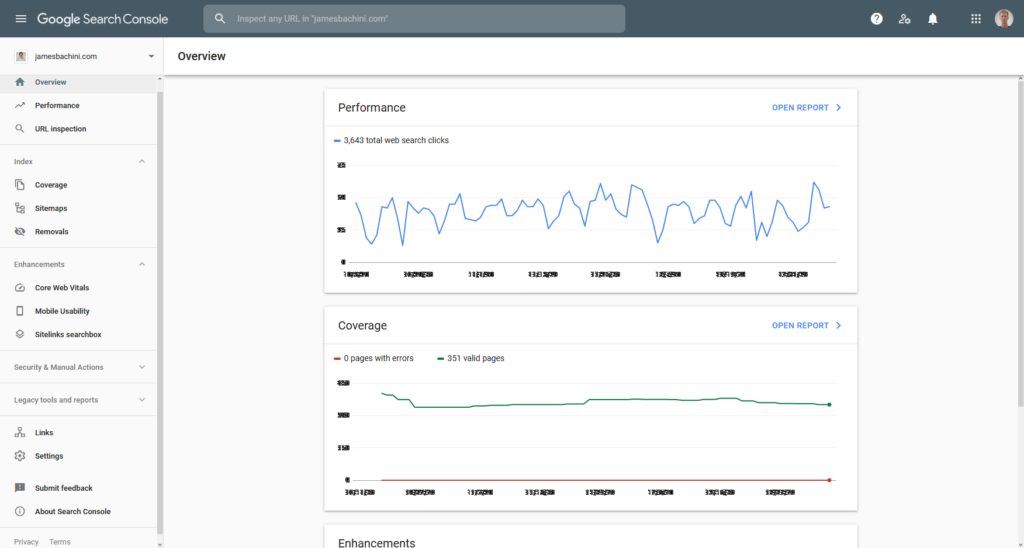
Google Tag Manager
Google Tag Manager is a application that streamlines the process of adding 3rd party tracking and conversion pixels.
Web developers can place one code snippet on their site which loads everything else. If the marketing team want to add a new pixel they can do this through the GTM interface without having to modify the website code.
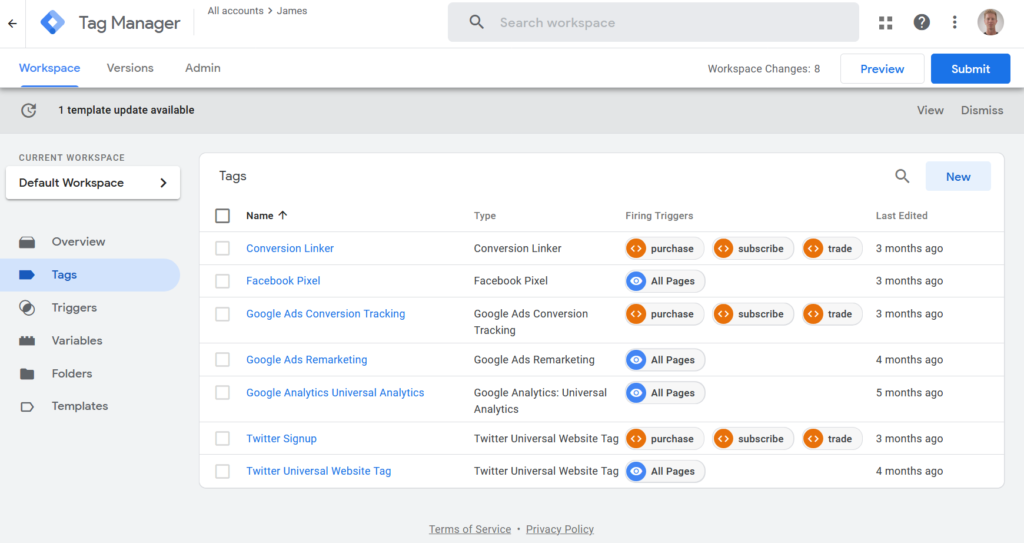
Guerrilla Marketing
Guerilla marketing is a creative marketing method to capture attention for a brand. It’s often shocking or surprising and always newsworthy. The idea is to create an event which gets talked about in mainstream media.
There’s a complete post on Guerrilla Marketing here:
https://jamesbachini.com/guerilla-marketing/
H1,H2,H3 Tags
These H tags are used as headings in HTML. The sub-title above is a H2 tag for example. Generally they are used in ascending order so:
- H1 – Main page title
- H2 – Section heading
- H3 – Subheading within a section
The code for a h1 tag looks like this:
<h1>My Title</h1>HTML – Hyper Text Markup Language
HTML forms the structure of every web page. It’s not really a coding language but a tag based structure where content fits within tags.
Here is a basic example of a web page
<html>
<h1>My Title</h1>
<p>Hello World</p>
</html>So in the simple example above everything is within the html tags. Then within those tags are a h1 tag which renders a heading and a p tag which renders a paragraph.
HTML is normally used alongside CSS and Javascript to form the trilogy of web languages. HTML provides the structure, CSS provides the style and Javsacript provides the engine.
Hashtag
A #hashtag is a work preceded with a hash symbol. This is used as markup on most social media sites to link to other related content.
Hashtags are usually searchable so adding a hashtag can often make content more discoverable. Using hashtags from trending topics is a slow but effective way to build a social media following.
Heatmaps
Heatmaps record user interaction with a web page. A small piece of Javascript code will record the on-page scrolling and mouse movements to give the developers some idea of where users are focusing their attention.
It can be used as part of the conversion rate optimisation process to provide insights in to how a page is being used.
I have never found them to be very useful so don’t use them regularly unless there is a specific need to.
IP Address
An IP address is a numeric address which is like your telephone number on the web. It’s made up of four numbers between 1 and 255 with decimal points in between.
56.34.1.139
Every computer that is connected to the internet will have an external IP address. If two computers are connected via the same Wi-Fi then the external IP will be the same but they will have different internal IP addresses and traffic will be directed via a router.
DNS is used to lookup the IP address of specific domain names.
Iframe
An iframe is like a web page within a web page. It can be used to mount a 3rd party site within your website. For example you can embed a video that is hosted on YouTube via an iframe.
The code looks something like this:
<iframe src="https://jamesbachini.com"></iframe> It’s worth noting that many sites like Google and Facebook use headers to prevent their sites being iFramed.
Influencer Marketing
Influencer marketing grew out of the dropshipping/ecom movement around 2015. Facebook Ad costs were going up and marketers turned to social media influencers to promote their products.
Influencer marketing is based on contacting someone on social media with a big following and paying them to endorse and promote your product or offer.
Most big influencers will do this regularly and have set prices for paid promotions.
Infographic
An infographic is a visual representation of data. These were extremely effective when they first became popular at creating backlinks.
Here’s an example of an infographic:

Notice how it’s tall and laid out almost like a web page. The idea is to create a shareable resource which provides value. If visitors find it valuable they may share it on social media gaining backlink and SEO juice for the site.
JS – JavaScript
Javascript is my most used programming language. It’s the only code that runs within a web browser so is essential for web development.
Node.js and Deno enables Javascript to be used on the backend web services as well. Cordova enables users to create mobile apps with Javscript. This is all part of the Javascript everywhere movement.
Here’s a simple javascript snippet that would run in a web browser.
<script>
const myVariable = 5;
if (6 > myVariable ) {
alert('Hello World');
}
</script>Jump Page
A jump page is another word for a landing page. It’s specific really to affilliate offers where the jump page sits between the traffic source and the affiliate network.
Affiliates will send traffic to their jump page from a traffic source such as Facebook Ads, they might collect an email address or just use it to pre-sell an offer. Somewhere on the jump page there will be a big call to action button that will take the visitor through to the final offer or merchant site.
KPI – Key Performance Indicators
Key performance indicators are the marketing or business metrics that matter most to business success.
These might be revenues or return on ad spend or number of visitors.
There’s a whole post on KPI’s and KPI dashboards here:
Defining Key Performance Indicators
Keyword Density
Keyword density is the number of times I mention online marketing glossary in this blog post. In the very early days of SEO all you needed to do was create a post with the keyword in the title, h1 tag, description and scatter the keyword liberally throughout the blog post. Throw a couple of PBN links at it and you’d be golden.
These days keyword density isn’t anywhere near the as important. Having said that companies like RankMath still consider it a ranking factor and have stats for it in their dashboard.
Just in case “online marketing glossary”
LTV – Lifetime Value
This the total spend over the course of a customer lifetime. So if the average customer subscribes to a service for $10/month and they stay an average of 6 months before cancelling the LTV is $60.
Landing Page
A landing page is a web page specifically created to receive a visitor from a traffic source. Good landing pages track performance and are optimised using conversion tracking data and a CRO process.
Landing pages communicate the value of the offer to the customer and often create a sense of urgency to take immediate action.
Text on landing pages should always communicate how the customer will directly benefit not just how great the company/product is.
Here is the anatomy of a typical landing page:

Lead Magnet
A lead magnet is usually a digital product that is exchanged for an email address. This forms part of a sales funnel where the marketer will then send out an autoresponder email series to the visitors email address.
Lead magnets can be things like:
- eBooks
- Infographics
- Original research
- Lists of tips & tricks
- Industry guidelines
- Cheat sheet
- Toolkit / resources list
- Video transcript
- Mp3 download
- Recorded webinar
- Consultation
- Online demos
- Free trials
- How To/Instructions
- Slides
- Newsletter
- Free shipping
- Quiz/survey
- Online tools or audits
- Spreadsheet template
- Mindmap
- Anything printable
There’s a full post on lead magnets here:
Lead Magnets, Autoresponders and Tripwires
Lead Nurturing
Lead nurturing is the process of developing visitors into customers. This is usually carried out through a sales funnel. Lead nurturing builds trust and familiarity between the business and the potential customer.
Effective lead nurturing methods can include email marketing, content marketing, retargeting campaigns and sales calls.
Lookalike Audience
A lookalike audience is a form targeting used by ad exchanges. Marketers can create custom audiences using customer email lists or website visitor tracking. From there they can create a lookalike audience based on similar traits to the custom audience.
For example a business might want to create a lookalike advertising campaign to find new users like their existing customers.
Some of the biggest ad networks such as Google Ads and Facebook Ads provide lookalike targeting options which are highly effective for scaling campaigns.
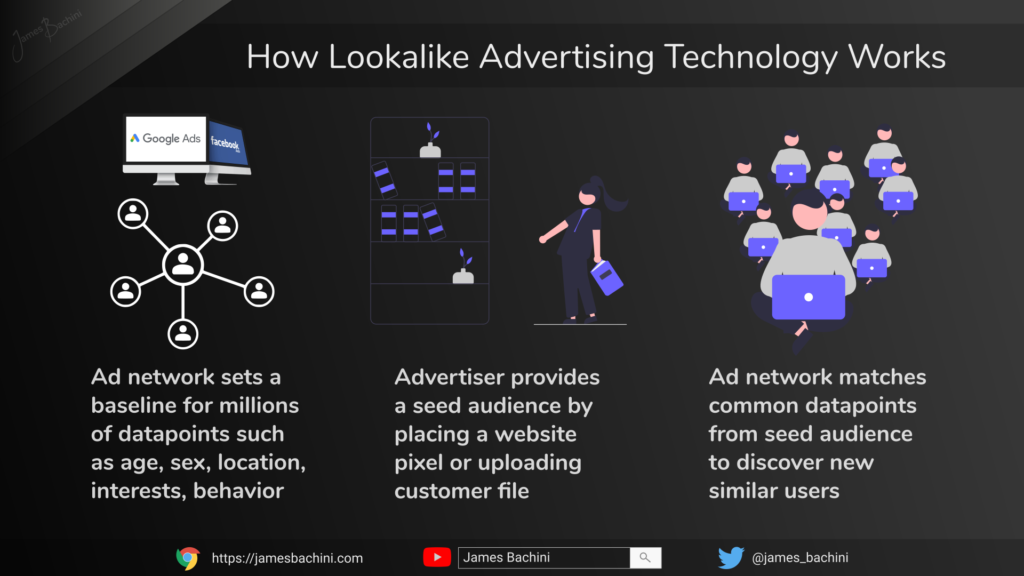
There’s a whole blog post on lookalike audiences here:
Lookalike Audience | What, Why & Tips For Building Lookalike Audiences
Loss Aversion
Loss aversion is the marketing psychology principle that people are more inclined to take action to prevent a loss than to make an equally sized gain.
This is used throughout digital marketing to create urgency for direct response campaigns.
Sites like Amazon use promotional text such as “Only 1 Remaining” because it creates a fear of missing out FOMO for the visitor compelling them to place an immediate order.
MRR – Monthly Recurring Revenue
MRR is the amount of revenue received from subscription based customers for the previous month who are expected to rebill the current month. Monthly recurring revenue is one of the most important business metrics for subscription based business and SaaS startups.
Marketing Automation
Marketing automation takes a lot of the manual work out of running digital marketing campaigns. Advertising campaigns can be optimized automatically using software to analyse the performance of different sources and adjust budgets accordingly.
I like to think I was an early adopter and pioneer of marketing automation technology as I was developing automation systems as early as 2010 to optimize sources and analyse stats across a range of advertising networks.
Some advertising networks now offer in-built automation to optimize campaigns and publisher id’s. I’d be wary of using these as ad networks have a conflict of interest with advertisers in that they want to sell the most inventory at the highest possible price whereas advertisers want the best inventory at the lowest possible price.
Automation allows you to do more with limited resources. It makes it possible to high volume campaigns across thousands of publishers without having to manage an army of virtual assistants.
Market Research
Market research is the process of assessing public opinion for an idea, brand or product. Effective market research provides insights that can take some of the guess work out of launching a new product or business.
Market research can be conducted via:
- Online Surveys
- Minimum Viable Products
- Interviews and Video Calls
- Social Media
Meta Tags (Meta Description & Meta Keywords)
Meta tags are part of the HTML structure of a page. They provide additional data to search engines and web browsers. Meta keywords is for the most part redundant after it was widely abused for SEO purposes.
The meta description tag however is critical as alongside the title tag it forms the text for the search engine listing. Click through rate is a ranking factor so having a high click through rate search engine listing will get more clicks and move the listing up the rankings.
The meta description tag looks like this:
<meta name="description" content="Learn this one simple trick to getting a higher click through rate and better search engine rankings 🔥">MVP – Minimum Viable Product
A minimum viable product is the simplest effective form of a product available. It is created quickly to test market response. MVP’s are simple but effective without the bells and wistles.
Online entrepreneurs will launch MVP’s before committing large amounts of development time to a project. This is because most projects fail due to insufficient demand. Developers, myself included, have a tendency to build stuff no one wants.
Mobile First
The mobile first movement is a design concept where the app or website is created for the smallest screensize first. From there it easier to scale up a design to utilise more space than it is trying to fit a complex desktop platform into a mobile device.
Mobile first design encourages elegant simplicity.
MV Testing
MV testing or multivariate testing involves A/B testing lots of different components of a landing page or sales funnel at the same time. This is a form of conversion rate optimisation which is used to improve digital marketing campaign performance.
NLP – Neuro Linguistic Programming
NLP is a method of using language to create a behavioural response. It is used in marketing and copywriting to influence purchase decisions and build brand associations.
In it’s simplest form certain words carry visual and memory associations. Using a specific word in the context of a product or brand can create a hook or link between the product and the visitors feelings elicited by that word.
Probably the most widely used NLP method in marketing is the use of “power words” in titles and headlines. There are certain words and phrases online that are proven over and over again to get high click through rates.
News Hacking
News hacking is a form of guerilla marketing where an event is created to gain attention from the mainstream media.
My favourite example of this was when Virgin Atlantic boss Richard Branson scrambled a blimp to antagonise rival British Airways. It made headlines and earned marketing rewards.

Niche
A niche or market niche is a specific industry or interest based sector. It can be used as a verb to “niche down” is to focus on a more targeted audience.
So a digital marketing team might look at the coffee industry as a sector and a specific niche within that might be focused on consumers that want high end light roasted speciality coffee.
Additionally this is pronounced neeessh in British English and nitsch in American English.
Organic Traffic
Organic traffic is the free web traffic that Google sends from it’s unpaid search results. Organic traffic can also be used to describe unpaid social traffic from links in posts.
Webmasters practice SEO to optimise their websites rankings and gain more organic traffic. While Google is not the only search engine they do have a 90%+ market share so they are the dominant player in this space.
PPC – Pay-Per-Click
Pay per click campaigns are campaigns focused around paid search traffic. At the top of the search engine results pages there are paid promotions that look like organic results for many queries. Marketers can use Google Ads and Bing Ads to access this inventory.
Pay per click marketing is particularly effective when focusing on purchase intent. It’s the number one platform for find users who are actively searching for the solutions your company offers.
PBN – Private Blog Network
A private blog network is a network of blogs used for SEO purposes, primarily link building. One entity will setup multiple sites across various niches and a domains. They will use automated processes to manage these and develop them with the sole purpose of sending link juice to a “money site” which is trying to get higher rankings.
Private blog networks are often setup on expired domains as these often already have inbound links. This enables the PBN sites to funnel link juice to the money site increasing what used to be called PageRank.
Private blog networks are a form of black hat SEO. It’s hard to set them up without leaving traces and interconnections that can end up with the whole network getting delisted and the money site negatively affected.
PR – Public Relations
Public relations is the management and distribution of news relating to a business, product or brand. The aim of PR is to improve the communications and relationship between a brand and it’s potential customers.
In the digital age PR is focused around outreach. Here are some examples:-
- Sending out press releases to relevant news outlets
- Pitching stories to industry influencers and journalists
- Doing the podcast circuit
- Social media outlets and syndications
Page Speed
Page load speed is an important factor for both conversion rate optimisation and search engine optimisation. From a CRO perspective faster pages have a lower bounce rate and convert better. For SEO Google provides an optimisation tool for page speed insights:
https://developers.google.com/speed/pagespeed/insights/
Performance Marketing
Performance marketing is the method of using data and tracking to measure the effectiveness of digital marketing campaigns. Ads, landing pages and funnels are optimised continuously to improve return on ad spend.
Performance marketing is built on top of effective conversion tracking and analytics. By measuring how much each banner, landing page or funnel email is earning the business we can split test variations to figure out what works and what doesn’t.
If you are interested in performance marketing then check out this resource: Learn Digital Marketing
Pixel
A pixel in marketing terms refers to a tracking pixel. Today these are usually external javascript scripts that track user behaviour on your site. This got it’s name from when tracking was done via a trick where you would load a php file in an image pixel HTML tag and it would safely load the script in to a 1 pixel sized square on the site.
Here’s a modern tracking pixel from Facebook Ads (notice they still use the 1 pixel image for when javascript is disabled in the noscript tags):
<!-- Facebook Pixel Code -->
<script>
!function(f,b,e,v,n,t,s)
{if(f.fbq)return;n=f.fbq=function(){n.callMethod?
n.callMethod.apply(n,arguments):n.queue.push(arguments)};
if(!f._fbq)f._fbq=n;n.push=n;n.loaded=!0;n.version='2.0';
n.queue=[];t=b.createElement(e);t.async=!0;
t.src=v;s=b.getElementsByTagName(e)[0];
s.parentNode.insertBefore(t,s)}(window, document,'script',
'https://connect.facebook.net/en_US/fbevents.js');
fbq('init', '1234566789');
fbq('track', 'PageView');
</script>
<noscript><img height="1" width="1" style="display:none"
src="https://www.facebook.com/tr?id=123456789&ev=PageView&noscript=1"
/></noscript>
<!-- End Facebook Pixel Code -->Pop Up / Pop Under
Pop under ads are digital advertisements which span a new tab or window. A pop up or pop over displays on top of the current page, a pop under is loaded behind the current page so you only see it when you close the existing tab.
Pops are a highly effective marketing placement and command a CPM price roughly 10x more than banners. They have also earned a bad reputation because of their intrusive nature.
Programmatic Advertising
Programmatic advertising is a form of automated advertising where bid bots are connected to an exchange API to bid on inventory.
The exchange will provide a request to the bot for bid with all the data such as IP address, geolocation, device etc. Then the marketer’s bot will provide a bid response stating how much they’ll pay for that placement. The ad exchange will collect up bids and sell the placement to the highest bidder. Their ad will be loaded on to the page. All this happens within 0.2 seconds.
Programmatic advertising is only really suitable for high volume campaigns with the backing of a developer team.
ROAS – Return on Ad Spend
ROAS or return on ad spend is the revenue generated from the cost of an advertising campaign. It is a key performance metric for performance marketing campaigns.
ROAS is calculated by dividing the revenue by the ad spend. So if a ad campaign costs $100 and generates $300 revenue 300/100 = 3
RSS Feed – Really Simple Syndication
RSS is a method of packaging up content to be read by an application. WordPress blogs contain RSS feeds which let RSS syndicators grab the latest content from around the web.
Here is the RSS feed for this blog: https://jamesbachini.com/feed/
RSS is similar to HTML in that it’s structured with tags.
Rebill
A rebill is when a product is billed monthly or annually via a subscription. Rebill offers are affiliate offers which are based on a subscription service and often payout lifetime referral commissions.
Referral
A referral is when an affiliate sends a visitor to a merchant site. The visitor is referred by the affiliate. If the visitor goes on to make a purchase then the merchant will provide referral commissions in accordance with their affiliate program.
Referral traffic can also mean traffic coming from organic links in 3rd party sites.
Responsive
Responsive is a web design concept where a page is flexible and adjusts to the display screen size. This was originally achieved by using width: 50%; CSS commands but now there are things like FlexBox which make it much easier to create responsive layouts.
Retargeting / Remarketing
Retargeting is a digital marketing method that involves tracking users that visited your site or uploading a customer email list to segment an audience on an ad exchange. Ads can then be set up to display to that segmented audience, following them around the web.
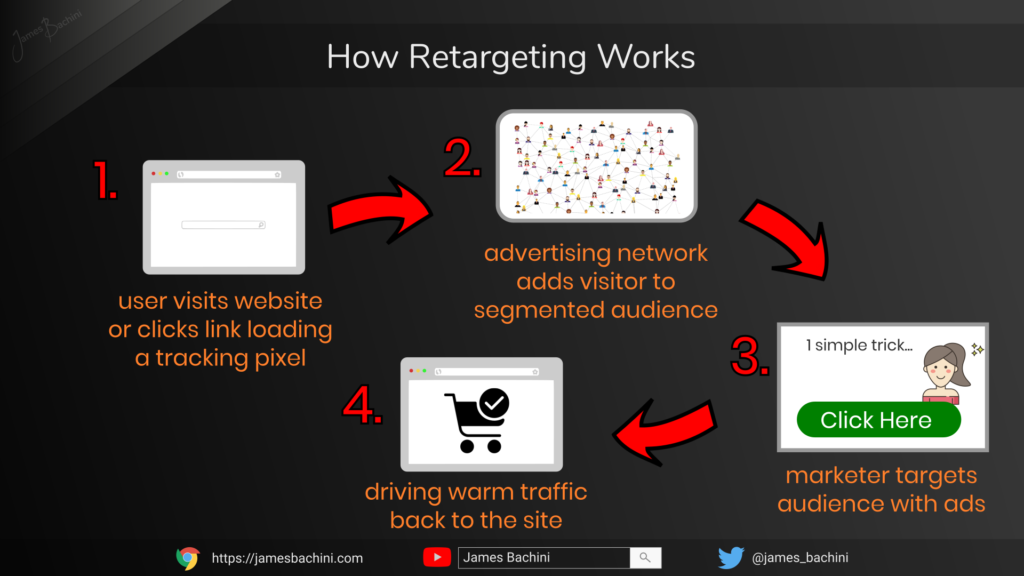
Retargeting campaigns are normally very effective and provide high return on ad spend.
Robots.txt
A robots.txt file can be placed in the root of a domain to give instructions to search engine crawlers about what content should not be indexed.
You can see the robots.txt file for this site here:
https://jamesbachini.com/robots.txt
Which is just a plain text file with this in it:
User-agent: *
Disallow: /wp-admin/
Allow: /wp-admin/admin-ajax.php
Sitemap: https://jamesbachini.com/sitemap_index.xmlS2S Pixel (Server To Server)
A S2S Pixel, also known as a postback pixel or ping is a conversion tracking method where one server will notify another one of a conversion event. It takes place in the backend server code rather than placing a pixel directly on the visitors browser.
S2S tracking is used a lot in affiliate marketing to communicate between and update tracking systems.
From a users perspective to set it up you just have to copy the S2S Pixel URL from one tracking system to the affiliate network’s tracking platform. When a conversion goes through the merchant will notify the affiliate platform, the affiliate platform will then pay out a commission and fire the S2S pixel updating your tracking platform.
SEO – Search Engine Optimisation (SEM – Search Engine Marketing)
Search engine optimisation is the practice of optimising content and generating backlinks and social signals to improve rankings in the Google search results.
SEO can be broken down into on-site and off-site factors.
On-Site SEO
This may include things like keyword research or optimising title tags and meta descriptions to improve click through rates. It can also form part of a broader content strategy to build up organic traffic over a period of time.
Off-Site SEO
This is often associated with outreach, guest blogging and generally getting content out there. Backlinks and social signals are key to gaining enough authority in a niche to push the site to the top of the search engine results.
There’s an in depth guide to SEO here:
SEO Content & How To Rank On Google
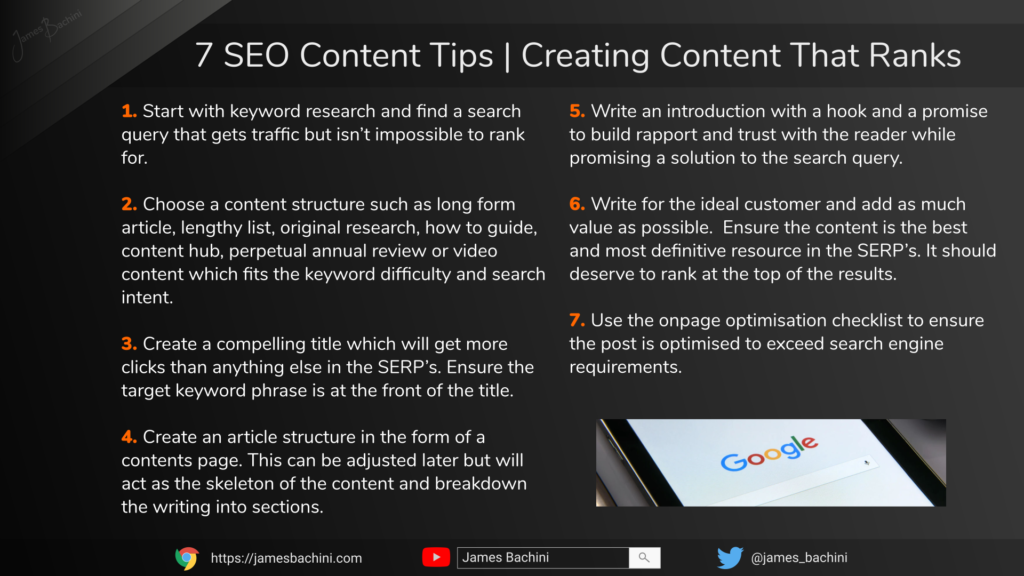
SERP – Search Engine Results Page
This is a SERP or search engine results page:
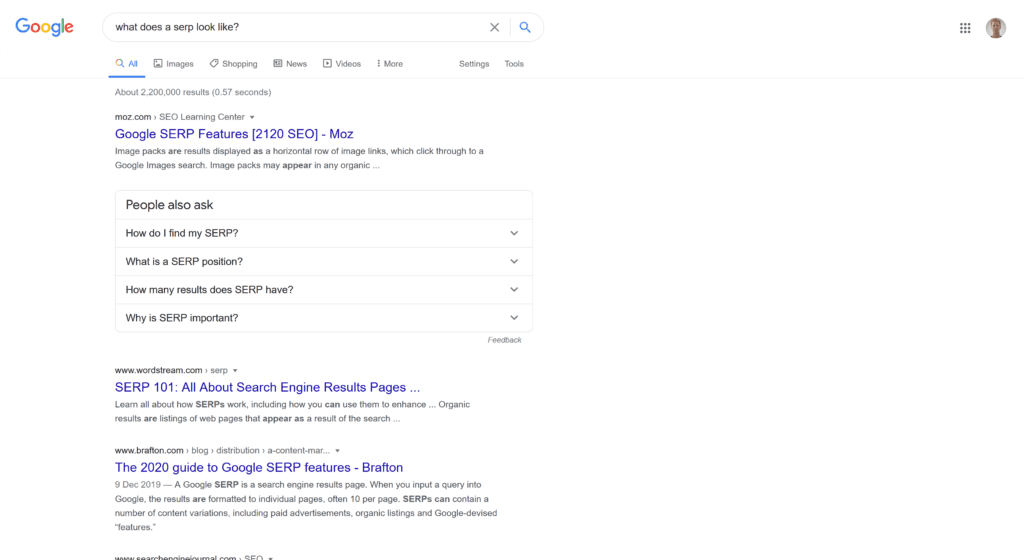
It is literally the search engine results that Google shows for a query. SERP rankings are defined by where your site lists in these results with the first organic listing being No.1.
SSL HTTPS
SSL is a secure standard for encrypting communications between a web browser and the websites server. It can be setup by purchasing and hosting a SSL certificate or via an intermediary cache provider.
SSL is a ranking factor for Google’s ranking algorithm and is generally considered a must have for SEO purposes.
SWOT Analysis
A SWOT analysis is a table which describes a businesses strengths, weaknesses, opportunities and threats.
SWOT analysis is used often in business and marketing plans. It’s a good way to explore the current situation and get a high level overview of the business challenges.
Sales Funnel
A sales funnel is a series of steps that a client will go through on the way to becoming a customer.
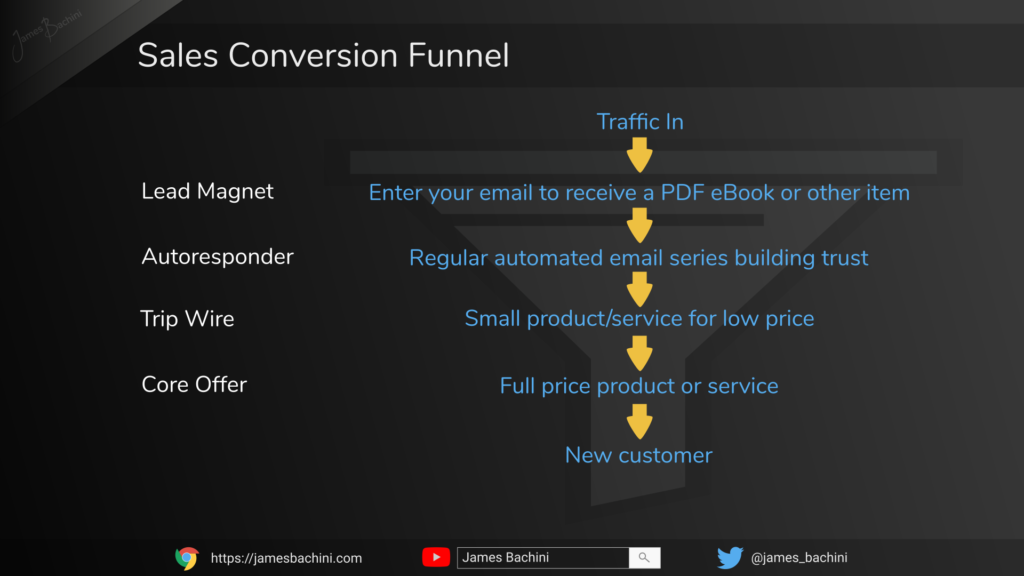
In the example above traffic enters the funnel from a traffic source where they will land on a landing page offering a PDF document in exchange for their email address.
The idea is that it segments audiences into potential buyers and tyre kickers. If someone isn’t willing to provide an email address tehy aren’t likely to be buyers either.
Once an email is submitted the visitor will receive a series of automated emails known as an autoresponder.
A tripwire is the next stage which is a low cost product which offers exceptional value. This turns leads into customers and exceeds expectations for the first purchase.
At this stage of the funnel tripwire customers are much more likely to purchase a offers core products or services. They are warmed up and trust has been built over a period of time.
Generally the higher cost a product the more elaborate and lengthy a sales funnel needs to be.
There’s more information here:
Lead Magnets, Autoresponders & Tripwires | The Modern Sales Funnel
Search Engine Spider
A search engine spider or crawler is a bot that visits web pages and collects information on them to collate in to the search results.
Bots will discern what the page is about, gauge quality and track outgoing links.
A search engine spider will use either a sitemap or follow the links on the page to scan through a site to index all the necessary pages.
Search Query
A search query is what you type into Google when doing a search.
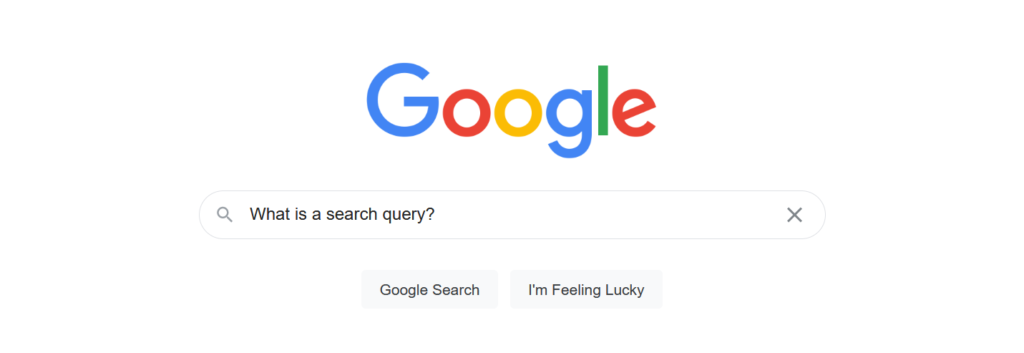
From a marketing perspective the key thing is search intent. Content needs to be created inline with what the searcher wants to find.
Sitemap
A sitemap is a list of URL’s provided for a search engine spider. It is usually in XML or TXT format and can be submitted via the Google Search Console.
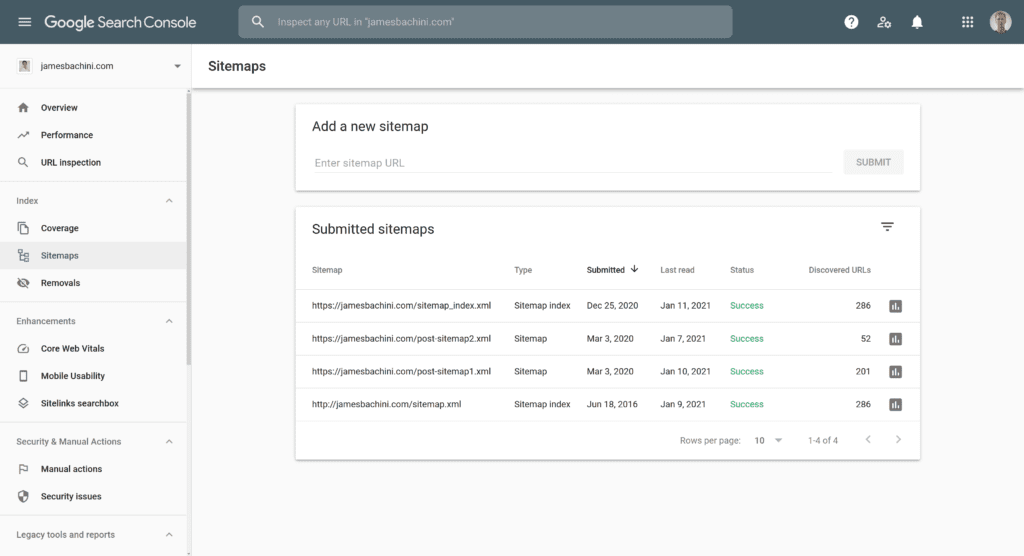
Sitemaps aren’t essential but they do help index content and guide Google’s search crawlers to the structure of our site and the content that should and should not be listed.
There are plenty of WordPress plug-ins which can generate a sitemap. Custom developers can just dump all the URL’s in plaintext to a file (one per line) and upload that.
Spam
Spam is unsolicited promotional communications. Spam was born out of the email boom in the 1990’s. It became big business and even to this day there are black hat email marketers who generate huge profits.
Spam filters do a reasonable job of cutting out 90% of unsolicited bulk mail but it’s a cat and mouse game for spammers to beat the filters.
Spam is sent via SMTP relays, these are mail servers that are setup and warmed up to look like genuine email providers. Once some reputation has been built up a centralized script will distribute bulk emails to a network of SMTP relays spreading the source IP addresses.
Tracking
Tracking is the concept of recording the visitor interactions with a web property. This may be in the form of a visitor count or more advanced event based tracking for things like “add to cart” buttons clicked or “form completions”.
Tracking provides the data necessary to optimise campaigns and continually improve performance of marketing efforts.
Tripwire
Tripwire products are low cost items that are an easy sell. They are not developed to produce company profits but to turn visitors into customers who will be more inclined to purchase core products in the future.
Tripwires are often small samples or demonstrations of value. They should exceed customer expectations. It’s the perfect opportunity for a brand to showcase their core value proposition and build trust with the customer.
URL – Uniform Resource Locator
A URL is a web address. It contains a number of parts:-
- https:// – this tells the web browser we want to connect via SSL to a web server
- www. – this is a sub domain
- jamesbachini.com – this is the top level domain name
- /marketing/ – this is the directory, which provides site structure
- index.php – this is the web page or file
- ?user=123&q=asdf – query parameter, used for tracking
- #section1 – finally a div ID which will scroll to the relevant content on the page.
URL’s should be formatted to look attractive and clickworthy when shared on social media and in backlinks. My preferred format is:
https://domain.com/category/page-title
This is SEO friendly and makes it simple to understand what the page is about just by looking at the URL. Query parameters can be added such as UTM tracking variables but these will be removed when indexed due to canonical tags.
USP – Unique Selling Point
A unique selling point differentiates a product or brand from it’s competitors. A business with a USP is said to have a moat which makes it harder for other businesses and new market entrants to compete.
Finding a USP isn’t easy and there is usually a balance between niche down and making a product attractive to the widest audience.
A unique selling point could be a recognised fashion label, a government contract or a location unlike anywhere else.
UTM Tracking
UTM tracking variables are used with Google Analytics to record information about where a visitor came from.
With Google Analytics installed on a site we can add the following parameters to a URL.
https://jamesbachini.com?utm_source=facebookAds&utm_campaign=xmasSpecial3&utm_medium=socialAds
These are then tracked within the Google Analytics platform and marketers can see how many visits the URL has received and what events those visitors have generated (i.e. revenues).
UX – User Experience
User Experience is an art form that aims to make the use of a website or application as intuitive as possible. The site should be a pleasure to navigate and provide a simple yet full featured experience.
It should also have a dark mode.
Uniques
Uniques is short for unique visitors. It’s the number of individual visitors a web site or landing page gets.
A single visitor may have multiple sessions and page impressions but they are still only counted as a single unique.
Viral Marketing
Viral marketing is the method of creating content to spread organically around the internet. This generally needs to be shocking, surprising or elicit some type of emotion to gain attention. There also needs to be a compelling reason for the visitor to share the content.
A viral coefficient can be calculated based on how often a piece gets shared. A viral coefficient above 1 means that the ad will have some viral growth as on average every visitor is sharing it with more than on new visitor.
Virality online can happen very quickly. If you are attempting to conduct this type of marketing it’s important to get servers and everything in place to handle high volumes.
Wireframe
A wireframe is like a digital sketch of how a website or application will work. It’s a design tool that helps visualise and plan the layout before you start writing code.
Wireframes can help pitch concepts to investors and also to communicate ideas between internal teams.

WordPress
WordPress started out as a blogging platform but quickly became the go to content management system for the web. It is now said to power 33% of the worlds websites, an incredible feat. It’s open-source software wand free to use although you will need a domain name and a web host.
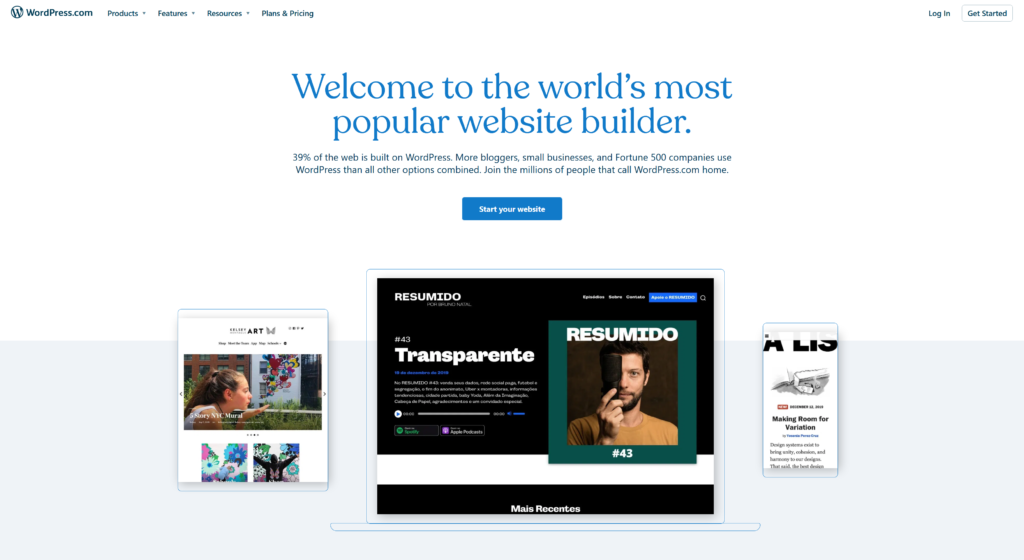
XML – Extensible Markup Language
XML is a tag based markup language or data structure used for RSS feeds and sitemaps. It’s used more for server to server communications than by web browsers.
Here is a simple XML file:
<?xml version="1.0"?>
<Marketing>
<Name>
Marketing Glossary
</Name>
<Description>
All the marketing definitions you didn't want to know
</Description>
<URL>
https://jamesbachini.com
</URL>
</Marketing>If you are interested in learning more about online marketing then check out the free digital marketing course.
If you’ve enjoyed these resources could you help share this content on social media and send it to anyone who you think might benefit from it.
Thank you.




